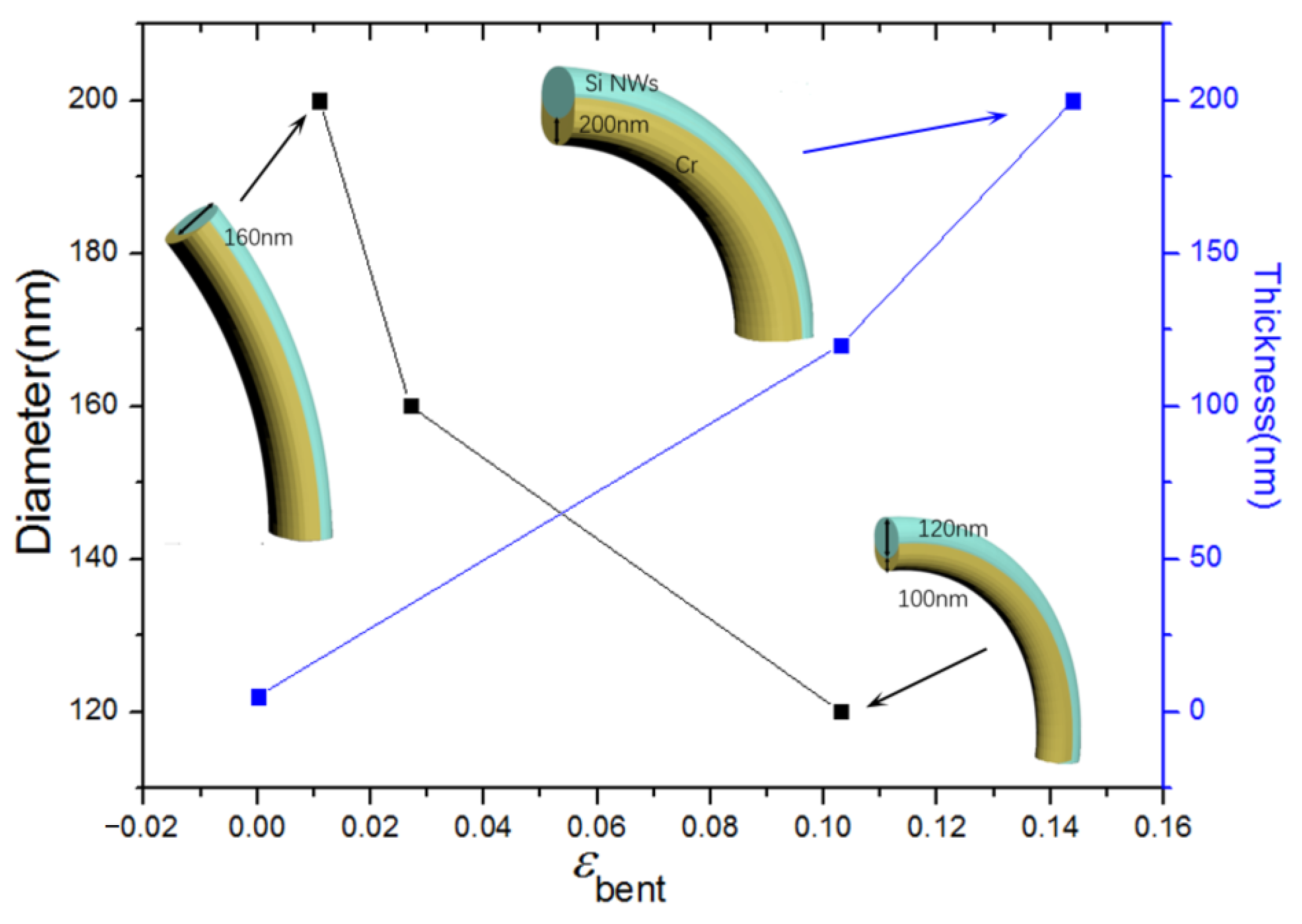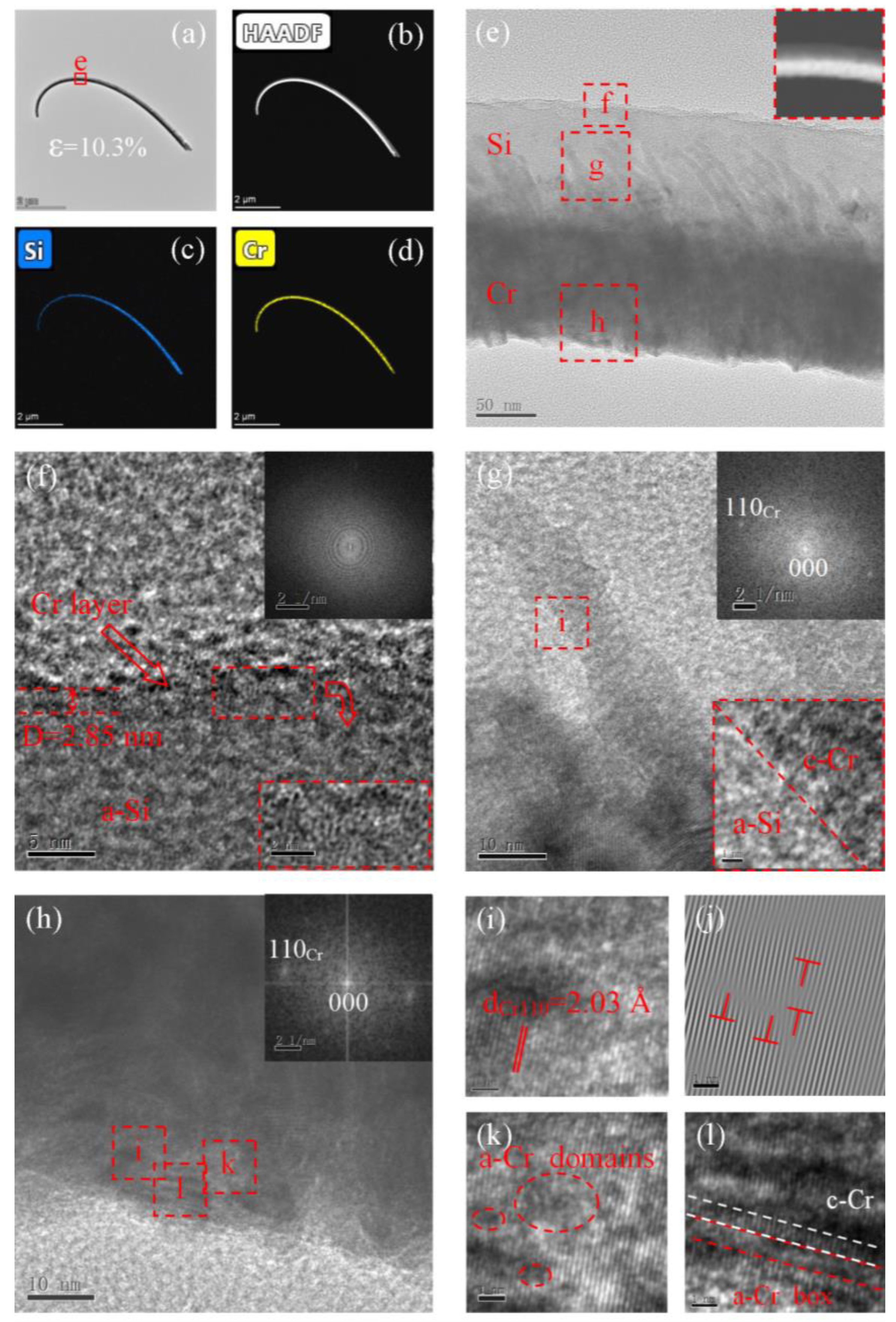TEM Investigation of Asymmetric Deposition-Driven Crystalline-to-Amorphous Transition in Silicon Nanowires
Abstract
1. Introduction
2. Experimental Section
3. Results and Discussion
4. Conclusions
Supplementary Materials
Author Contributions
Funding
Institutional Review Board Statement
Informed Consent Statement
Data Availability Statement
Conflicts of Interest
References
- Cui, Y.; Zhong, Z.; Wang, D.; Wang, A.W.U.; Lieber, C.M. High Performance Silicon Nanowire Field Effect Transistors. Nano Lett. 2003, 3, 149–152. [Google Scholar] [CrossRef]
- Chau, M.; Englander, O.; Lin, L. Silicon nanowire-based nanoactuator. In Proceedings of the IEEE-NANO Third IEEE Conference on Nanotechnology, San Francisco, CA, USA, 12–14 August 2003; pp. 879–880. [Google Scholar]
- Chan, C.K.; Peng, H.; Liu, G.; McIlwrath, K.; Zhang, X.F.; Huggins, R.A.; Cui, Y. High-performance lithium battery anodes using silicon nanowires. Nat. Nanotechnol. 2008, 3, 31–35. [Google Scholar] [CrossRef]
- Tian, B.; Zheng, X.; Kempa, T.; Fang, Y.; Yu, N.; Yu, G.; Huang, J.; Lieber, C.M. Coaxial silicon nanowires as solar cells and nanoelectronic power sources. Nature 2007, 449, 885–889. [Google Scholar] [CrossRef] [PubMed]
- Hsin, C.-L.; Mai, W.; Gu, Y.; Gao, Y.; Huang, C.-T.; Liu, Y.; Chen, L.-J.; Wang, Z.-L. Elastic Properties and Buckling of Silicon Nanowires. Adv. Mater. 2008, 20, 3919–3923. [Google Scholar] [CrossRef]
- San Paulo, Á.; Arellano, N.; Plaza, J.A.; He, R.; Carraro, C.; Maboudian, R.; Howe, R.T.; Bokor, A.J.; Yang, P. Suspended Mechanical Structures Based on Elastic Silicon Nanowire Arrays. Nano Lett. 2007, 7, 1100–1104. [Google Scholar] [CrossRef]
- Han, X.; Kou, L.; Lang, X.; Xia, J.; Wang, N.; Qin, R.; Lu, J.; Xu, J.; Liao, Z.; Zhang, X.; et al. Electronic and Mechanical Coupling in Bent ZnO Nanowires. Adv. Mater. 2010, 21, 4937–4941. [Google Scholar] [CrossRef]
- In, Y.; Wang, X.; Wang, Z.L. Microfibre–nanowire hybrid structure for energy scavenging. Nature 2008, 451, 809–813. [Google Scholar] [CrossRef]
- Lin, X.; He, X.B.; Yang, T.Z.; Guo, W.; Shi, D.X.; Gao, H.-J.; Ma, D.D.D.; Lee, S.T.; Liu, F.; Xie, X.C. Intrinsic current-voltage properties of nanowires with four-probe scanning tunneling microscopy: A conductance transition of ZnO nanowire. Appl. Phys. Lett. 2006, 89, 043103. [Google Scholar] [CrossRef]
- Zheng, K.; Han, X.; Wang, L.; Zhang, Y.; Yue, Y.; Qin, Y.; Zhang, X.; Zhang, Z. Atomic Mechanisms Governing the Elastic Limit and the Incipient Plasticity of Bending Si Nanowires. Nano Lett. 2009, 9, 2471–2476. [Google Scholar] [CrossRef]
- Han, X.D.; Zheng, K.; Zhang, Y.F.; Zhang, X.N.; Zhang, Z.; Wang, Z.L. Low-Temperature In Situ Large-Strain Plasticity of Silicon Nanowires. Adv. Mater. 2007, 19, 2112–2118. [Google Scholar] [CrossRef]
- Efremov, M.D.; Bolotov, V.; Volodin, V.; Fedina, L.I.; Lipatnikov, E.A. Excimer laser and rapid thermal annealing stimulation of solid-phase nucleation and crystallization in amorphous silicon films on glass substrates. J. Physics: Condens. Matter 1996, 8, 273–286. [Google Scholar] [CrossRef]
- Tang, D.-M.; Ren, C.-L.; Wang, M.-S.; Wei, X.; Kawamoto, N.; Liu, C.; Bando, Y.; Mitome, M.; Fukata, N.; Golberg, D. Mechanical Properties of Si Nanowires as Revealed by in Situ Transmission Electron Microscopy and Molecular Dynamics Simulations. Nano Lett. 2012, 12, 1898–1904. [Google Scholar] [CrossRef]
- Wang, L.; Zheng, K.; Zhang, Z.; Han, X. Direct Atomic-Scale Imaging about the Mechanisms of Ultralarge Bent Straining in Si Nanowires. Nano Lett. 2011, 11, 2382–2385. [Google Scholar] [CrossRef] [PubMed]
- He, Y.; Zhong, L.; Fan, F.; Wang, C.; Zhu, T.; Mao, S.X. In situ observation of shear-driven amorphization in silicon crystals. Nat. Nanotechnol. 2016, 11, 866–871. [Google Scholar] [CrossRef]
- Wang, Y.; Zhang, W.; Wang, L.-Y.; Zhuang, Z.; Ma, E.; Li, J.; Shan, Z.-W. In situ TEM study of deformation-induced crystalline-to-amorphous transition in silicon. NPG Asia Mater. 2016, 8, e291. [Google Scholar] [CrossRef]
- Vincent, L.; Patriarche, G.; Hallais, G.; Renard, C.; Gardès, C.; Troadec, D.; Bouchier, D. Novel Heterostructured Ge Nanowires Based on Polytype Transformation. Nano Lett. 2014, 14, 4828–4836. [Google Scholar] [CrossRef] [PubMed]
- Vincent, L.; Djomani, D.; Fakfakh, M.; Renard, C.; Belier, B.; Bouchier, D.; Patriarche, G. Shear-driven phase transformation in silicon nanowires. Nanotechnology 2018, 29, 125601. [Google Scholar] [CrossRef]
- Lewis, R.B.; Corfdir, P.; Küpers, H.; Flissikowski, T.; Brandt, O.; Geelhaar, L. Nanowires Bending over Backward from Strain Partitioning in Asymmetric Core–Shell Heterostructures. Nano Lett. 2018, 18, 2343–2350. [Google Scholar] [CrossRef]
- Shen, Y.; Hong, J.-I.; Xu, S.; Lin, S.; Fang, H.; Zhang, S.; Ding, Y.; Snyder, R.L.; Wang, Z.L. A General Approach for Fabricating Arc-Shaped Composite Nanowire Arrays by Pulsed Laser Deposition. Adv. Funct. Mater. 2010, 20, 703–707. [Google Scholar] [CrossRef]
- Shen, Y.; Hong, J.-I.; Peng, Z.; Fang, H.; Zhang, S.; Dong, S.; Snyder, R.L.; Wang, Z.L. Tuning the Shape and Strain in Micro/Nanowires by a Sideways Physical Deposition Process. J. Phys. Chem. C 2010, 114, 21277–21280. [Google Scholar] [CrossRef][Green Version]
- Hilse, M.; Takagaki, Y.; Herfort, J.; Ramsteiner, M.; Herrmann, C.; Breuer, S.; Geelhaar, L.; Riechert, H. Ferromagnet-semiconductor nanowire coaxial heterostructures grown by molecular-beam epitaxy. Appl. Phys. Lett. 2009, 95, 133126. [Google Scholar] [CrossRef]
- Xu, Y.K.; Li, L.B.; Zang, Y.; Hu, J.C.; Li, Z.B.; Chen, H.; Zhang, G.Q.; Xia, C.J.; Cho, J.H. Forward bending of silicon nanowires induced by strain distribution in asymmetric growth. Mater. Lett. 2021, 297, 129929. [Google Scholar] [CrossRef]
- Hochbaum, A.I.; Fan, R.; He, A.R.; Yang, P. Controlled Growth of Si Nanowire Arrays for Device Integration. Nano Lett. 2005, 5, 457–460. [Google Scholar] [CrossRef]
- Zhigunov, D.M.; Kamaev, G.; Kashkarov, P.K.; Volodin, V.A. On Raman scattering cross section ratio of crystalline and microcrystalline to amorphous silicon. Appl. Phys. Lett. 2018, 113, 023101. [Google Scholar] [CrossRef]
- Lee, Y.-J.; Kwon, J.-D.; Kim, D.-H.; Nam, K.-S.; Jeong, Y.; Kwon, S.-H.; Park, S.-G. Structural characterization of wavelength-dependent Raman scattering and laser-induced crystallization of silicon thin films. Thin Solid Films 2013, 542, 388–392. [Google Scholar] [CrossRef]




Publisher’s Note: MDPI stays neutral with regard to jurisdictional claims in published maps and institutional affiliations. |
© 2022 by the authors. Licensee MDPI, Basel, Switzerland. This article is an open access article distributed under the terms and conditions of the Creative Commons Attribution (CC BY) license (https://creativecommons.org/licenses/by/4.0/).
Share and Cite
Zang, Y.; Li, L.; Hu, J.; Li, L.; Li, Z.; Li, Z.; Feng, S.; Zhang, G.; Xia, C.; Pu, H. TEM Investigation of Asymmetric Deposition-Driven Crystalline-to-Amorphous Transition in Silicon Nanowires. Materials 2022, 15, 7077. https://doi.org/10.3390/ma15207077
Zang Y, Li L, Hu J, Li L, Li Z, Li Z, Feng S, Zhang G, Xia C, Pu H. TEM Investigation of Asymmetric Deposition-Driven Crystalline-to-Amorphous Transition in Silicon Nanowires. Materials. 2022; 15(20):7077. https://doi.org/10.3390/ma15207077
Chicago/Turabian StyleZang, Yuan, Lianbi Li, Jichao Hu, Lei Li, Zelong Li, Zebin Li, Song Feng, Guoqing Zhang, Caijuan Xia, and Hongbin Pu. 2022. "TEM Investigation of Asymmetric Deposition-Driven Crystalline-to-Amorphous Transition in Silicon Nanowires" Materials 15, no. 20: 7077. https://doi.org/10.3390/ma15207077
APA StyleZang, Y., Li, L., Hu, J., Li, L., Li, Z., Li, Z., Feng, S., Zhang, G., Xia, C., & Pu, H. (2022). TEM Investigation of Asymmetric Deposition-Driven Crystalline-to-Amorphous Transition in Silicon Nanowires. Materials, 15(20), 7077. https://doi.org/10.3390/ma15207077




